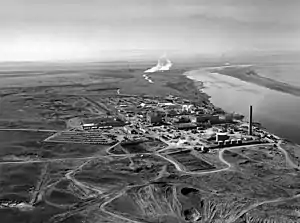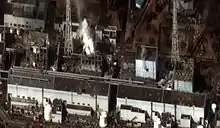Radioactive contamination
Radioactive contamination or radiological contamination is the contamination of the environment with radioactive materials, where these materials are not present. Many radioactive substances have very long half lives; this means that if they are present in the envioroment, they can be dangerous for a very long time. Many nuclear power plants produce such substances; usually they are processed to radioactive waste. There is little danger that comes from radioactive waste,if it is stored safely.

The Hanford site represents two-thirds of the United States' high-level radioactive waste by volume. Nuclear reactors line the riverbank at the Hanford Site along the Columbia River in January 1960.

As of 2013, the Fukushima nuclear disaster site remains highly radioactive. About 160,000 people still live in temporary housing. Some land will be unfarmable for centuries. The difficult cleanup job will take 40 or more years, and cost tens of billions of dollars.[1][2]

The 18,000 km2 expanse of the Semipalatinsk Test Site (indicated in red), which covers an area the size of Wales. The Soviet Union conducted 456 nuclear tests at Semipalatinsk from 1949 until 1989 with little regard for their effect on the local people or environment. The full impact of radiation exposure was hidden for many years by Soviet authorities and has only come to light since the test site closed in 1991.[3]

2007 ISO radioactivity danger symbol. The red background is intended to convey urgent danger, and the sign is intended to be used in long-term radioactive waste repositories, which might survive into a distant future where other danger symbols may be forgotten or misinterpreted.
Causes
- Incidents in nuclear power plants
- Nuclear medicine uses radiation for the treatment of illnesses. Sometimes, there are accidents.
- Explosions in nuclear facilities (and atomic bombs) cause nuclear fallouts: This means that nuclear particles are scattered using normal atmospheric phenomena, such as the weather
- Nuclear reprocessing can contaminate water
Accidents
| Year | Type | Incident | ARS deaths | ARS survivors | Location |
|---|---|---|---|---|---|
| 1945 | criticality | Harry K. Daghlian | 1 | 0 | Los Alamos, New Mexico, United States |
| 1946 | criticality | Pajarito accident (Louis Slotin) | 1 | 2 | Los Alamos, New Mexico, United States |
| 1957 | alleged crime | Nikolay Khokhlov assassination attempt[4] | 0 | 1 | Frankfurt, West Germany |
| 1958 | criticality | Cecil Kelley criticality accident | 1 | 0 | Los Alamos, New Mexico, United States |
| 1961 | reactor | Soviet submarine K-19[5] | 8 | many | North Atlantic, near Southern Greenland |
| 1961 | criticality | SL-1 experimental reactor explosion | 2 | 0 | NRTS, near Idaho Falls, Idaho, United States |
| 1962 | orphan source | radiation accident in Mexico City | 4 | ? | Mexico City, Mexico |
| 1968 | reactor | Soviet submarine K-27[6] | 9 | 40 | near Gremikha Bay, Russia |
| 1985 | reactor | Soviet submarine K-431[7] | 10 | 49 | Chazhma Bay naval facility near Vladivostok, USSR |
| 1985 | radiotherapy | Therac-25 radiation overdose accidents | 3 | 3 | |
| 1984 | orphan source | radiation accident in Morocco[8] | 8 | 3 | Mohammedia, Morocco |
| 1986 | reactor | Chernobyl disaster | 28 | 206 - 209 | Chernobyl Nuclear Power Plant, Ukrainian SSR |
| 1987 | orphan source | Goiânia accident[9] | 4 | ? | Goiânia, Brazil |
| 1990 | radiotherapy | radiotherapy accident in Zaragoza[10] | 11 | ? | Zaragoza, Spain |
| 1996 | radiotherapy | radiotherapy accident in Costa Rica[11] | 7 to 20 | 46 | San José, Costa Rica |
| 1999 | criticality | Tokaimura nuclear accident | 2 | ? | Tōkai, Ibaraki, Japan |
| 2000 | orphan source | Samut Prakan radiation accident[12] | 3 | 7 | Samut Prakan Province, Thailand |
| 2000 | radiotherapy | Instituto Oncologico Nacional accident[13][14] | 3 to 7 | ? | Panama City, Panama |
| 2006 | crime | Poisoning of Alexander Litvinenko[4][15][16][17][18] | 1 | 0 | London, United Kingdom |
| 2010 | orphan source | Mayapuri radiological accident[12] | 1 | 7 | Mayapuri, India |
References
- Richard Schiffman (12 March 2013). "Two years on, America hasn't learned lessons of Fukushima nuclear disaster". The Guardian.
- Martin Fackler (June 1, 2011). "Report Finds Japan Underestimated Tsunami Danger". New York Times.
- Togzhan Kassenova (28 September 2009). "The lasting toll of Semipalatinsk's nuclear testing". Bulletin of the Atomic Scientists.
- Goldfarb, Alex; Litvinenko, Marina (2007). Death of a Dissident: The Poisoning of Alexander Litvinenko and the Return of the KGB. Simon & Schuster UK. ISBN 978-1-4711-0301-8.
- Johnston, Wm. Robert. "K-19 submarine reactor accident, 1961". Database of radiological incidents and related events. Johnston's Archive. Retrieved 24 May 2012.
- Johnston, Wm. Robert. "K-27 submarine reactor accident, 1968". Database of radiological incidents and related events. Johnston's Archive. Retrieved 24 May 2012.
- Johnston, Wm. Robert. "K-431 submarine reactor accident, 1985". Database of radiological incidents and related events. Johnston's Archive. Retrieved 24 May 2012.
- "Lost Iridium-192 Source".
- The Radiological Accident in Goiania p. 2.
- Strengthening the Safety of Radiation Sources Archived 2009-03-26 at the Wayback Machine p. 15.
- Gusev, Igor; Guskova, Angelina; Mettler, Fred A. (12 December 2010). Medical Management of Radiation Accidents, Second Edition. CRC Press. pp. 299–303. ISBN 978-1-4200-3719-7.
- Bagla, Pallava (7 May 2010). "Radiation Accident a 'Wake-Up Call' For India's Scientific Community". Science. 328 (5979): 679. Bibcode:2010Sci...328..679B. doi:10.1126/science.328.5979.679-a. PMID 20448162.
- International Atomic Energy Agency. "Investigation of an accidental Exposure of radiotherapy patients in Panama" (PDF).
- Johnston, Robert (September 23, 2007). "Deadliest radiation accidents and other events causing radiation casualties". Database of Radiological Incidents and Related Events.
- Patterson AJ (2007). "Ushering in the era of nuclear terrorism". Critical Care Medicine. 35 (3): 953–4. doi:10.1097/01.CCM.0000257229.97208.76. PMID 17421087.
- Acton JM, Rogers MB, Zimmerman PD; Brooke Rogers; Zimmerman (September 2007). "Beyond the Dirty Bomb: Re-thinking Radiological Terror". Survival. 49 (3): 151–168. doi:10.1080/00396330701564760. S2CID 154617638.
{{cite journal}}: CS1 maint: multiple names: authors list (link) - Sixsmith, Martin (2007). The Litvinenko File: The Life and Death of a Russian Spy. True Crime. p. 14. ISBN 978-0-312-37668-0.
- Bremer Mærli, Morten. "Radiological Terrorism: "Soft Killers"". Bellona Foundation. Archived from the original on 2007-12-17. Retrieved 2014-11-15.
This article is issued from Wikipedia. The text is licensed under Creative Commons - Attribution - Sharealike. Additional terms may apply for the media files.